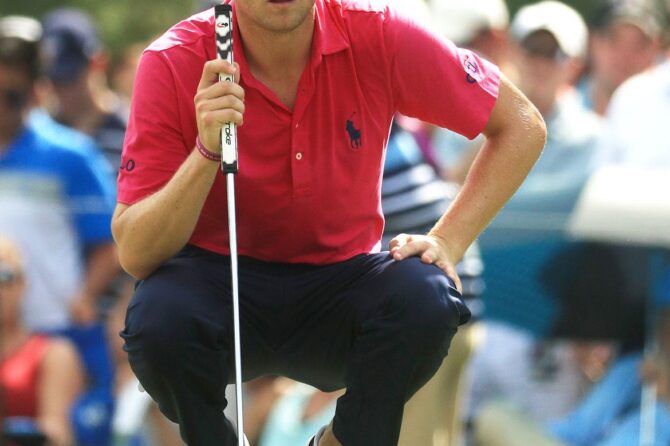Amateur golfers often lose strokes due to poor chipping technique. Even minor flaws in the chipping swing can result in significant distance and accuracy problems. This article identifies two common chipping flaws that can crush a player’s short game and provides simple tips for correcting them.
Chipping Flaw #1: Incorrect Weight Distribution
Incorrect Weight Distribution
Every chip shot begins with a proper setup. Unfortunately, if your weight isn’t distributed correctly, you’re setting yourself up for an inaccurate shot and a potential skull.
Generally speaking, you’ll want 60 percent of your weight on your lead foot and 40 percent on your trail foot. This weight distribution promotes a solid base and allows you to make a smooth, consistent swing. However, many golfers unknowingly shift their weight too far back during the setup, putting more weight on their heels. This imbalance can cause the club to swing too steeply, which results in a thin shot.
To correct this weight distribution issue, you can try:
Using a mirror to check your form. Make sure your weight is evenly distributed from your shoulders to your feet.
Standing up straight and then leaning forward from the hips. This will help engage your core muscles and promote a balanced stance.
Chipping Flaw #2: Mishitting the Ball
Mishitting the Ball: A Major Chipping Flaw
Mishitting the ball while chipping is a common error that can drastically hinder your short game performance. This occurs when the club head does not strike the ball squarely, resulting in a variety of negative outcomes.
Consequences of Mishitting:
Inconsistent Distance: Mishitting the ball often leads to imprecise distance control. The ball may travel shorter or farther than intended, affecting your ability to land on target.
Off-Line Shots: A mis-hit chip can cause the ball to veer left or right of your intended line. This can be especially problematic when the green is narrow or well-protected by bunkers.
Loss of Spin: Mishitting the ball can reduce backspin, which is essential for stopping the chip shot quickly on the green.
Causes of Mishitting:
Mishitting can result from several factors, including:
Incorrect Club Selection: Using a club that is too long or too short can make it difficult to sweep the ball cleanly.
Poor Stance and Alignment: A poor setup can throw off your body and club alignment, leading to mis-hits.
Misjudging the Distance: Miscalculating the distance to the green can cause you to over- or under-hit the chip.
Overcoming Chipping Flaws: Tailored Practice Techniques
Chipping Flaw #1: Flinching Hands
Flinching hands occur when your hands jerk back upon impact.
Cause: Fear of hitting the ball too hard or thinning it.
Fix: Focus on making a smooth swing and keeping your hands steady. Practice hitting foam balls or pillows to desensitize your hands.
Chipping Flaw #2: Inconsistent Clubface Angle
This flaw results in inconsistent contact and distance control.
Cause: Failure to rotate the clubface into the ball consistently.
Fix: Use alignment aids (e.g., a clubshaft) to ensure a square clubface at impact. Practice chipping from different lies to improve clubface control.
Table: Impact Angle Chipping Techniques
| Impact Angle | Technique |
|—|—|
| Descending | Place the ball slightly ahead of your feet. Use a steep downward swing to generate backspin. |
| Level | Position the ball halfway between your feet. Create a slight divot behind the ball. |
| Ascending | Set the ball on a tee or coin. Approach the ball with a slightly upward swing. |
Mental Strategies for Overcoming Flaws
Identify your flaws: Film yourself chipping and analyze your swing.
Create a practice plan: Focus on drills and exercises that address your specific weaknesses.
* Stay patient: Improvement takes time and consistent effort. Don’t get discouraged by setbacks.
by eliminating these two common chipping errors—addressing the ball with your weight too far forward and not swinging through the ball with sufficient speed—you can instantly upgrade your short game performance and develop a more consistent and reliable chipping stroke. Remember, practice and repetition are key, so spend some dedicated time refining your chipping technique and you will notice a significant improvement in your ability to get up and down from around the green.





